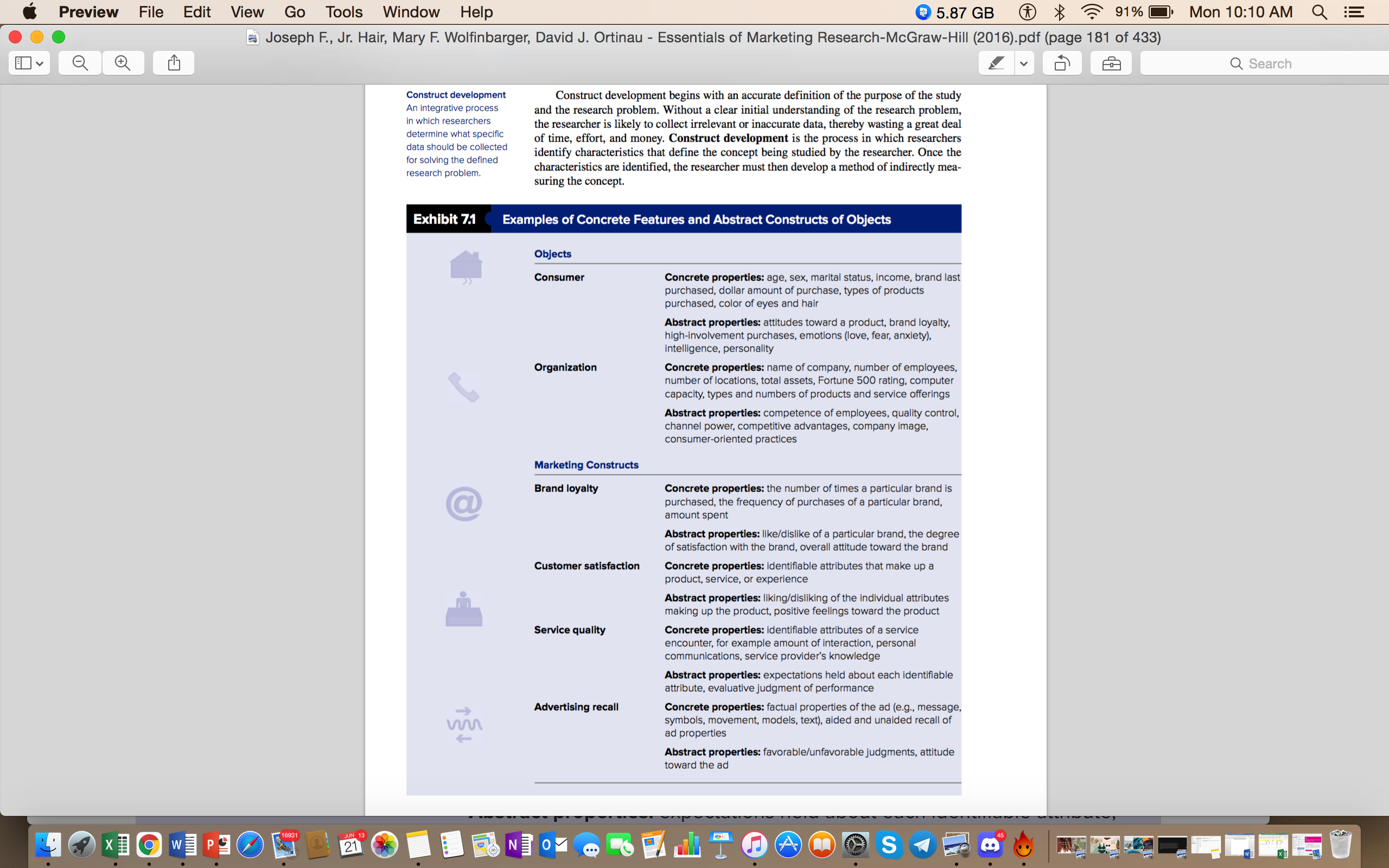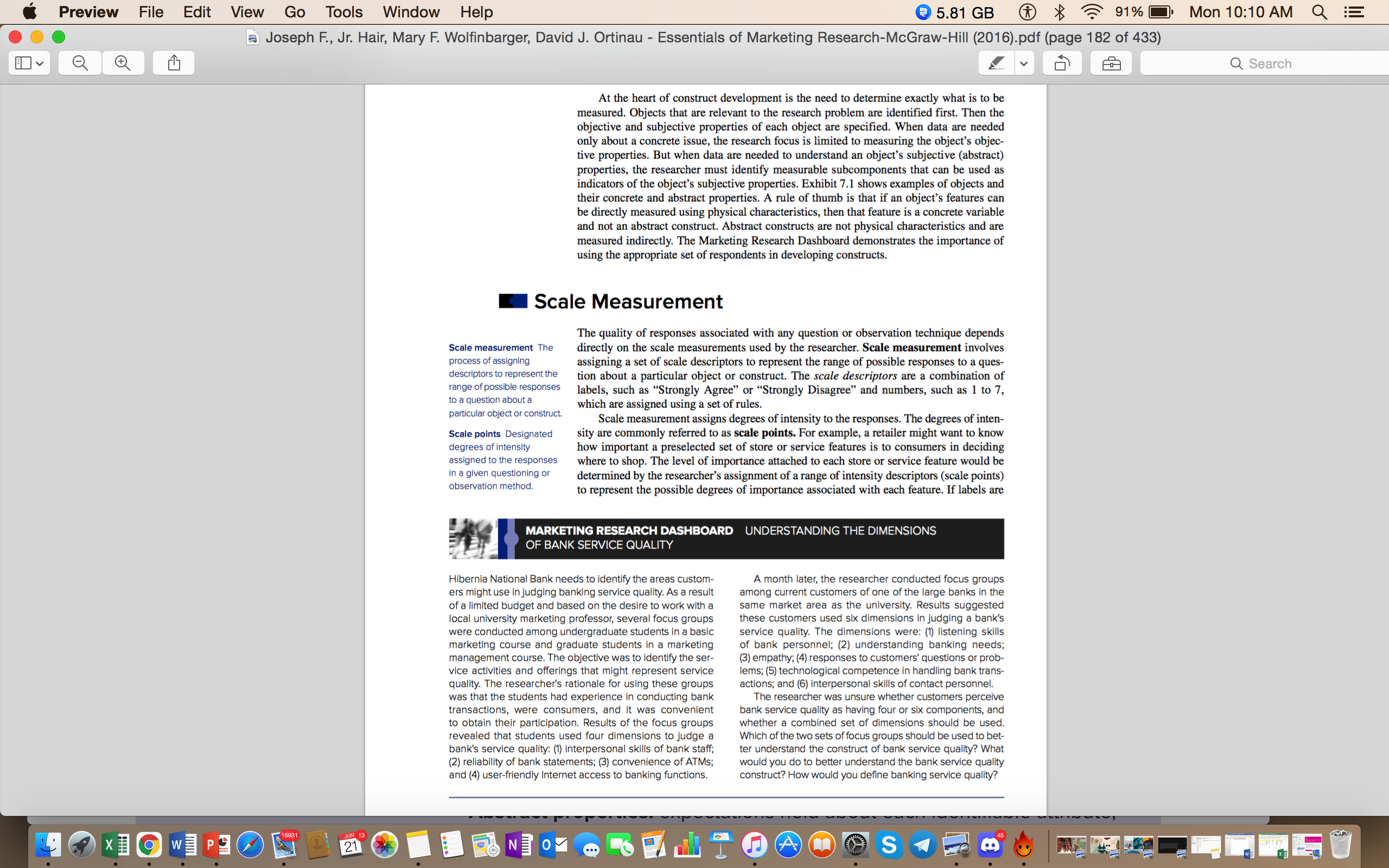Preview File Edit it View v Go Tools Window Help 5.75 GB 91% Mon 10:09 AM Q Joseph F., Jr. Hair, Mary F. Wolfinbarger, David J. Ortinau - Essentials of Marketing Research-McGraw-Hill (2016).pdf (page 180 of 433) I V Q Search What Is a Construct? A construct is an abstract idea or concept formed in a person's mind. This idea is a com- bination of a number of similar characteristics of the construct. The characteristics are the variables that collectively define the concept and make measurement of the concept possible. For example, the variables listed below were used to measure the concept of "customer interaction."I This customer was easy to talk with. This customer genuinely enjoyed my helping her/him. This customer likes to talk to people. This customer was interested in socializing. This customer was friendly. This customer tried to establish a personal relationship This customer seemed interested in me, not only as a salesperson, but also as a person. By using Agree-Disagree scales to obtain scores on each of the individual variables, you can measure the overall concept of customer interaction. The individual scores are then combined into a single score, according to a predefined set of rules. The resultant score is often referred to as a scale, an index, or a summated rating. In the above example of customer interaction, the individual variables (items) are scored using a 5-point scale, with 1 = Strongly Disagree and 5 = Strongly Agree. Suppose the research objective is to identify the characteristics (variables) associated with a restaurant satisfaction construct. The researcher is likely to review the literature on satisfaction, conduct both formal and informal interviews, and then draw on his or her own experiences to identify variables like quality of food, quality of service, and value for money as important components of a restaurant satisfaction construct. Logical combina- tion of these characteristics then provides a theoretical framework that represents the sat- isfaction construct and enables the researcher to conduct an empirical investigation of the concept of restaurant satisfaction. Construct Development Construct A hypothetical Marketing constructs must be clearly defined. Recall that a construct is an unobservable variable made up of a set concept that is measured indirectly by a group of related variables. Thus, constructs are of component responses or made up of a combination of several related indicator variables that together define the behaviors that are thought concept being measured. Each individual indicator has a scale measurement. The construct to be related. being studied is indirectly measured by obtaining scale measurements on each of the indi- cators and adding them together to get an overall score for the construct. For example, cus- tomer satisfaction is a construct while an individual's positive (or negative) feeling about a specific aspect of their shopping experience, such as attitude toward the store's employ- ees, is an indicator variable. www.MyEbookNiche.cCrater.com 21Preview File Edit it View v Go Tools Window Help 5.87 GB B 91% Mon 10:10 AM Q = Joseph F., Jr. Hair, Mary F. Wolfinbarger, David J. Ortinau - Essentials of Marketing Research-McGraw-Hill (2016).pdf (page 181 of 433) I V Q Search Construct development Construct development begins with an accurate definition of the purpose of the study An integrative process and the research problem. Without a clear initial understanding of the research problem, in which researchers the researcher is likely to collect irrelevant or inaccurate data, thereby wasting a great deal determine what specific of time, effort, and money. Construct development is the process in which researchers data should be collected for solving the defined identify characteristics that define the concept being studied by the researcher. Once the research problem. characteristics are identified, the researcher must then develop a method of indirectly mea- suring the concept Exhibit 7.1 Examples of Concrete Features and Abstract Constructs of Objects Objects Consumer Concrete properties: age, sex, marital status, income, brand last purchased, dollar amount of purchase, types of products purchased, color of eyes and hair Abstract properties: attitudes toward a product, brand loyalty, high-involvement purchases, emotions (love, fear, anxiety), intelligence, personality Organization Concrete properties: name of company, number of employees, number of locations, total assets, Fortune 500 rating, computer capacity, types and numbers of products and service offerings Abstract properties: competence of employees, quality control, channel power, competitive advantages, company image, consumer-oriented practices Marketing Constructs Brand loyalty Concrete properties: the number of times a particular brand is OL purchased, the frequency of purchases of a particular brand, amount spent Abstract properties: like/dislike of a particular brand, the degree of satisfaction with the brand, overall attitude toward the brand Customer satisfaction Concrete properties: identifiable attributes that make up a product, service, or experience Abstract properties: liking/disliking of the individual attributes making up the product, positive feelings toward the product Service quality Concrete properties: identifiable attributes of a service encounter, for example amount of interaction, personal communications, service provider's knowledge Abstract properties: expectations held about each identifiable attribute, evaluation judgment of performance Advertising recall Concrete properties: factual properties of the ad (e.g., message, symbols, movement, models, text), aided and unaided recall of ad properties Abstract properties: favorable/unfavorable judgments, attitude toward the ad 21 SPreview File Edit it View v Go Tools Window Help 5.81 GB 91% Mon 10:10 AM Q = Joseph F., Jr. Hair, Mary F. Wolfinbarger, David J. Ortinau - Essentials of Marketing Research-McGraw-Hill (2016).pdf (page 182 of 433) Q Search At the heart of construct development is the need to determine exactly what is to be measured. Objects that are relevant to the research problem are identified first. Then the objective and subjective properties of each object are specified. When data are needed only about a concrete issue, the research focus is limited to measuring the object's object tive properties. But when data are needed to understand an object's subjective (abstract) properties, the researcher must identify measurable subcomponents that can be used as indicators of the object's subjective properties. Exhibit 7.1 shows examples of objects and their concrete and abstract properties. A rule of thumb is that if an object's features can be directly measured using physical characteristics, then that feature is a concrete variable and not an abstract construct. Abstract constructs are not physical characteristics and are measured indirectly. The Marketing Research Dashboard demonstrates the importance of using the appropriate set of respondents in developing constructs. Scale Measurement The quality of responses associated with any question or observation technique depends Scale measurement The directly on the scale measurements used by the researcher. Scale measurement involves process of assigning assigning a set of scale descriptors to represent the range of possible responses to a ques- descriptors to represent the tion about a particular object or construct. The scale descriptors are a combination of range of possible responses labels, such as "Strongly Agree" or "Strongly Disagree" and numbers, such as 1 to 7, to a question about a which are assigned using a set of rules. particular object or construct. Scale measurement assigns degrees of intensity to the responses. The degrees of inten- Scale points Designated sity are commonly referred to as scale points. For example, a retailer might want to know degrees of intensity how important a preselected set of store or service features is to consumers in deciding assigned to the responses where to shop. The level of importance attached to each store or service feature would be In a given questioning or determined by the researcher's assignment of a range of intensity descriptors (scale points) observation method. to represent the possible degrees of importance associated with each feature. If labels are MARKETING RESEARCH DASHBOARD UNDERSTANDING THE DIMENSIONS OF BANK SERVICE QUALITY Hibernia National Bank needs to identify the areas custom- A month later, the researcher conducted focus groups ers might use in judging banking service quality. As a result among current customers of one of the large banks in the of a limited budget and based on the desire to work with a same market area as the university. Results suggested local university marketing professor, several focus groups these customers used six dimensions in judging a bank's were conducted among undergraduate students in a basic service quality. The dimensions were: (1) listening skills marketing course and graduate students in a marketing of bank personnel; (2) understanding banking needs; management course. The objective was to identify the ser- 3) empathy; (4) responses to customers' questions or prob- vice activities and offerings that might represent service lems; (5) technological competence in handling bank trans- quality. The researcher's rationale for using these groups actions; and (6) interpersonal skills of contact personnel. was that the students had experience in conducting bank The researcher was unsure whether customers perceive transactions, were consumers, and it was convenient bank service quality as having four or six components, and to obtain their participation. Results of the focus groups whether a combined set of dimensions should be used. revealed that students used four dimensions to judge a Which of the two sets of focus groups should be used to bet- bank's service quality: (1) interpersonal skills of bank staff; ter understand the construct of bank service quality? What (2) reliability of bank statements; (3) convenience of ATMs; would you do to better understand the bank service quality and (4) user-friendly Internet access to banking functions. construct? How would you define banking service quality? 21 S









